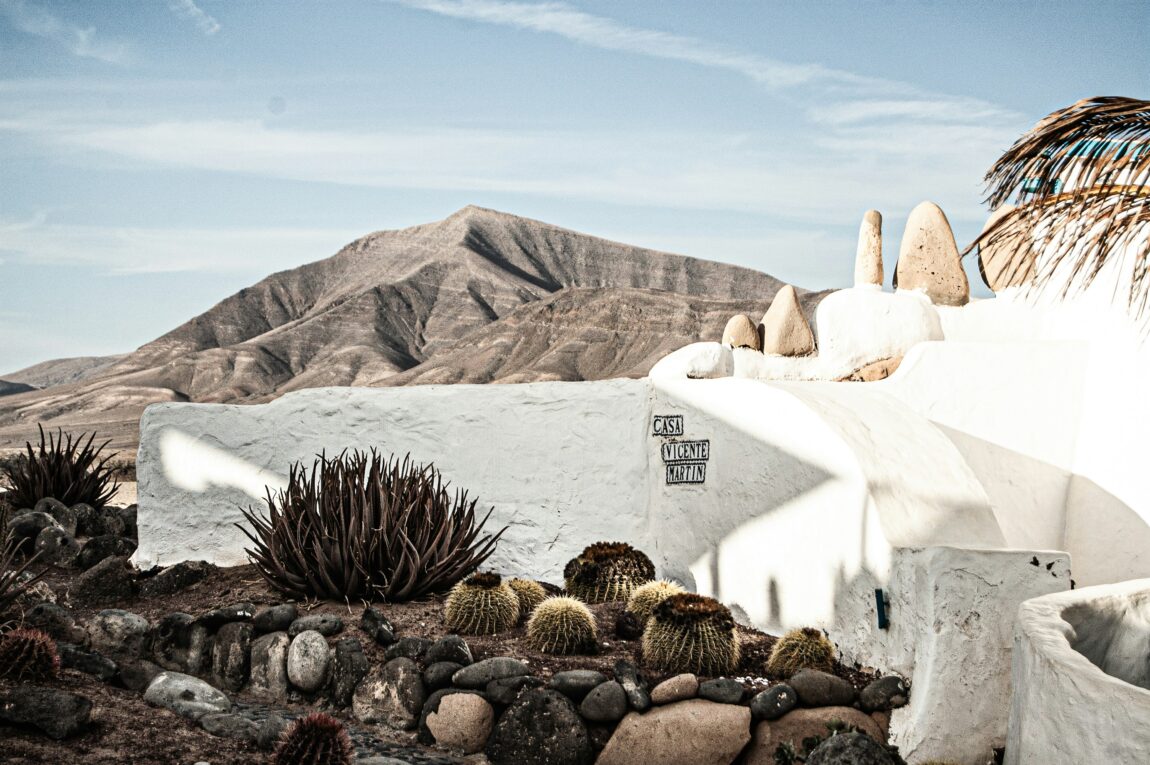
Volcano Corona hike boasts some of the most dramatic scenery on Lanzarote. Rising majestically above the charming village of Yé, its verdant slopes stand in sharp contrast to the island’s rugged volcanic landscape. Traverse the natural dirt track winding through vineyards, soak in the unique flora and fauna, and prepare to be mesmerized by the awe-inspiring views at the summit. From the massive crater to the shimmering Atlantic Ocean and the extensive lava tube network of Cueva de los Verdes, the panorama is breathtaking.
Discover how to visit this natural marvel with our comprehensive hiker’s guide.
About the Corona Volcano
Nestled close to the village of Yé in Haría, the towering Volcán de La Corona hike commands attention, soaring above the charming hamlets of Northern Lanzarote. Rising to an impressive height of 609 meters, its cone measures 269m in height and 1,500m in width, with the crater spanning 500m across.

The story behind the formation of Corona Volcano is fascinating and directly ties into the creation of geological wonders like malpaís, jameos, and the Atlantis Tunnel.
Formation of La Corona and Malpaís
Volcano La Corona erupted for the first time some 21.000 years ago, its formation happening in two main phases: an initial Strombolian eruption where the volcanic cone built up and a second phase dominated by effusive lava emission. The latter, in turn, can be subdivided into two different episodes that created Lanzarote as we know it today.
During the first one, smooth lava flowed down the volcano’s eastern side, covering older lava and enlarging the areal extent of the island toward the northeast by ∼100m beyond the former coastline. Later, thicker lava flowed out which only partially covered the lava field previously created. These two main effusive events produced a broad fan-shaped basaltic plateau of ∼18 km2, called by the locals the Malpaìs de La Corona.
Recognized for its captivating landscape and rich biodiversity, this area was declared a Natural Park in 1987 and elevated to the status of a Natural Monument in 1994, known today as the Monumento Natural del Malpaís de La Corona.
Formation of Atlantis Tunnel and Jameos
Malpaís, which translates to “bad country,” lives up to its name: it’s a desolate area with brittle lava that easily fractures underfoot. Yet, within its depths lie remarkable treasures born from the eruptions of Corona: the Tunnel of Atlantis and the jameos.
So, what exactly are they?
Corona’s eruptions didn’t just create the Malpaís; they also formed the Corona Volcanic Tube, stretching about 7.6 km in total length. About 6.0 km of it is above ground and within it, there are numerous skylights and roof collapses known as jameos. Among these, Cueva de los Verdes and Jameos del Agua stand out as two of the island’s most popular geological attractions.
The remaining 1.6 km is submerged below sea level due to subsequent marine activity. The submerged section, known as the Atlantis Tunnel, is the world’s longest volcanic submarine lava tube, reaching a depth of about 64 meters below sea level and ending abruptly, forming a large spherical cavity. Only select marine biologists have explored this section.
From Ashes into Green
The Malpaís may reign sublime, but it’s not all black around Corona! Surprisingly, this volcano boasts a lush green landscape teeming with plant life. Here’s how it happened:
While lava flowed eastward during the eruptions, ashes were carried southeastward by the wind, creating wide fertile plains that have long been utilized for farming. The indigenous people of Lanzarote, known as the majos, recognized the favorable conditions of this area for crop cultivation even before the arrival of the Spanish conquerors.

Today, as you traverse the northern slopes of Volcán de la Corona, you’ll pass through fields, mainly vineyards, adding vibrant greenery to the volcanic scenery.

How to Get to the Volcano La Corona Trailhead
To start the volcano Corona hike, head to the charming village of Yé, nestled in the municipality of Haría in the island’s northern region, near the popular Mirador del Río viewpoint.
When it comes to transportation, renting a car is your best bet for exploring Lanzarote, including reaching Volcano La Corona. Although buses are available, they are less frequent and take longer to reach the destination. Alternatively, guided tours are also an option for those who prefer organized exploration.
By Car
To reach Yé by car, simply set your GPS to this destination and follow the route. From Arrecife, you’ll typically head towards Arrieta via Tahíche on the LZ-1, then switch to the LZ-201 towards Mirador del Río.

Parking is available in front of the village church, with about 6-8 spots available. If the designated parking area is full, consider parking along the side of the road, ensuring not to cause any disruption.
How to Get to the Trailhead: From the parking area in front of the church in Yé, head eastward along the road (to the left of the church) towards the village. After about 300m, just past a kilometer marker indicating the 4th km, you’ll find a lava path on the right between two knee-high pillars. This marks the beginning of your gradual uphill hike.
By Bus
Take Bus Line #8 (old line #26) from Arrecife to Yé and alight at the “Yé” bus stop. The journey takes about an hour, nearly twice as long as by car due to multiple stops along the route.
How to Get to the Trailhead: Once off the bus, head west along the road. After 50 meters, you’ll spot the pillars marking the trailhead on your left.

Bus Information: For more details and schedules, visit this website.
By Tour
If you lack transportation or prefer guided hikes, consider joining a Corona Volcano tour. Many tours combine the Corona hike with a visit to the iconic Famara Cliffs. These tours typically include a knowledgeable guide, snacks, bottled water, and pickup service.
— Organized Tours —

The Hike to Corona Volcano
Hike Overview
Commencing from Yé, our hiking trail ascends towards the crater of La Corona volcano, meandering through the vineyards on its northern slopes. The trail concludes at the northern crater rim, providing a stunning view of the expansive crater. From there, you can continue along the trail around its eastern flank, offering breathtaking vistas of the Malpaís to the south and the Atlantic Ocean to the north.
The elevation change along the trail is 150 meters, with a relatively easy terrain overall. Towards the end, however, the path narrows and becomes slightly steep. This circular route covers a distance of 3,4 km and typically takes about an hour and a half to complete.
Section 1 – Ascending to Corona Volcano
The trail begins gently from the two knee-high pillars, offering an easy ascent with a slight incline. Along the way, you’ll be treated to insights into Lanzarote’s unique flora.

Did you know? The elevated terrain benefits the vegetation, as it sits above much of the cloud cover, allowing moisture from passing clouds to nourish the soil.
Initially, you’ll pass through fields where local farmers cultivate wine. Similar to elsewhere on the island, each plant is carefully enclosed within volcanic stone boundaries called socos, designed to conserve water and shield against strong winds.
Continuing along the well-defined path, you’ll find yourself surrounded by fig trees, while wild fennel and prickly pear plants also dot the landscape. Depending on the season, you may even catch sight of wild almonds bursting into delicate pink blossoms.
As you progress, the path ascends to a solitary palm tree, signaling the transition from a dirt path to a rocky track. From here, the trail becomes slightly steeper as it zigzags up to the ridge.
Section 2 – Gazing from Corona’s Summit
After completing the short ascent, the trail leads you to the northern crater rim, reaching a height of approximately 609 meters above sea level.
Upon reaching the caldera’s edge, your first instinct will likely be to peer down into the volcano’s crater. Take note of the eroding crust and the significant cracks within, indicating potential future collapses. Exercise caution near the edge, especially in strong winds, as you capture photos of the crater’s interior.

Note: While it was once possible to descend into the crater or traverse the ridge, these hikes are now prohibited and marked with signs indicating “Paso prohibido” (No passage).
Instead, take a moment to rest at the summit and soak in the breathtaking surroundings. Enjoy panoramic views extending across the island, especially on clear days. This vantage point is also ideal for birdwatching, as many migratory birds nest in the malpaís below.
Section 3 – Detouring & Taking the Way Back
For those feeling confident in their footing, a brief detour offers a rewarding experience. From the crater’s edge, a short climb leads to a viewpoint perched on the brink, reachable in under five minutes. Initially, a well-marked path guides the way, transitioning into a rugged rock surface.
At the viewpoint, soak in the breathtaking panorama stretching over the Malpaís de Corona down to the picturesque white houses of Punta Mujeres dotting the east coast. Notice the intricate cracks resembling caves on the ground; these are remnants of the volcano’s underground lava tunnels, seen most prominently at sites like Jameos del Agua and Cueva de los Verdes.
When it’s time to head back, retrace your steps down to the church along the familiar path used for the ascent.

Tip: While the return hike can be made circular, we advise against it. The alternate path is more challenging, lined with thorny bushes to dodge, offering little to see and risking unintentional trespassing on farmers’ fields.

Best Cafés and Restaurants
When it comes to dining options, Yé offers a couple of good spots worth trying. If you’re craving fresh seafood paired with ocean views, the quaint villages of Órzola and Arrieta, both about a 10-minute drive from Yé, are the places to go. Here are our top picks:
- Volcán de La Corona, Yé: A grill-asador serving mainly meat dishes.
- Teleclub, Yé: Local bar serving tapas, coffee, and desserts.
- Mirador El Roque, Órzola: Your go-to spot for fresh fish with seaside dining.
- La Nasa Restaurante El Norte, Órzola: Fresh seafood dishes and a cozy dining experience with sea views.
- El Pisquito, Arrieta: Outdoor restaurant serving seafood plates on a simple terrace overlooking the ocean.

Where to Stay near Corona Volcano
If you prefer an inland retreat close to the volcano, consider staying in Yé or Haría. Yé offers a tranquil atmosphere and easy access to La Corona’s hiking trails. About 6km away, Haría is nestled in the picturesque “Valley of a Thousand Palms” below La Corona Volcano.
For a coastal getaway, Órzola is a serene village near the island’s northern tip, offering excellent accommodation options and a ferry to La Graciosa. Alternatively, the fishing village of Arrieta offers a laid-back atmosphere and some nice eateries.

Where to Stay: Ikigai, Yé ~ Hotel Emblemático La Casa de los Naranjos, Haría ~ Apartamento Pirul, Haría ~ Cliff View, Órzola~ Eco Casa Gaviota, Arrieta
Travelers with campervans can consider Caletón Blanco Beach, just 9km away, for a spacious overnight spot. For a more intimate experience, Caleta de las Aulagas, about 13km southeast, offers less space but greater privacy. Plus, it’s close to Jameos del Agua, allowing you to beat the crowds and be among the first to visit.

When to Hike to Corona Volcano
Lanzarote enjoys favorable weather year-round due to its location off the coast of Morocco. However, it’s best to avoid the peak summer months of May to September when temperatures soar above 30°C, making hiking challenging. Instead, opt for the shoulder months of October to April.
For the best experience, plan your hike to the volcano in the late afternoon. Lanzarote often starts the day with cloudy weather, so visiting later ensures clear skies for breathtaking views. Avoid midday hikes when the sun is intense and there’s no shade along the trail.

Our Experience: Visiting Lanzarote in December, we encountered ideal hiking weather and enjoyed clear days perfect for outdoor activities. However, hiking to La Corona at midday proved too hot, and the harsh sunlight made it difficult to capture the best possible photos, both with our camera and our drone.

Tips for Hiking Corona Volcano
Remember, even if the hike seems easy, you’re still ascending a volcano. As such, it’s essential to follow some safety guidelines and show respect for the area and its residents. Here are a few helpful tips:
- Wind Protection: At the summit of Corona, it can get windy and humid. Bring a windbreaker jacket to stay warm. Also, be cautious near the crater edge.
- Time Your Hike: Try to avoid hiking during the midday sun as there is no shelter along the path.
- Stay on Track: Stick to the marked trails to avoid trespassing on farmers’ fields and disturbing the residents.
- Follow Signs: When you reach the summit, heed the signs. Avoid taking paths leading into the interior of the crater or attempting to circumnavigate the rim, as these are prohibited.
- Know Your Limits: If you’re not confident in your footing, avoid attempting the detour to the summit. Safety should always come first, so assess your abilities!